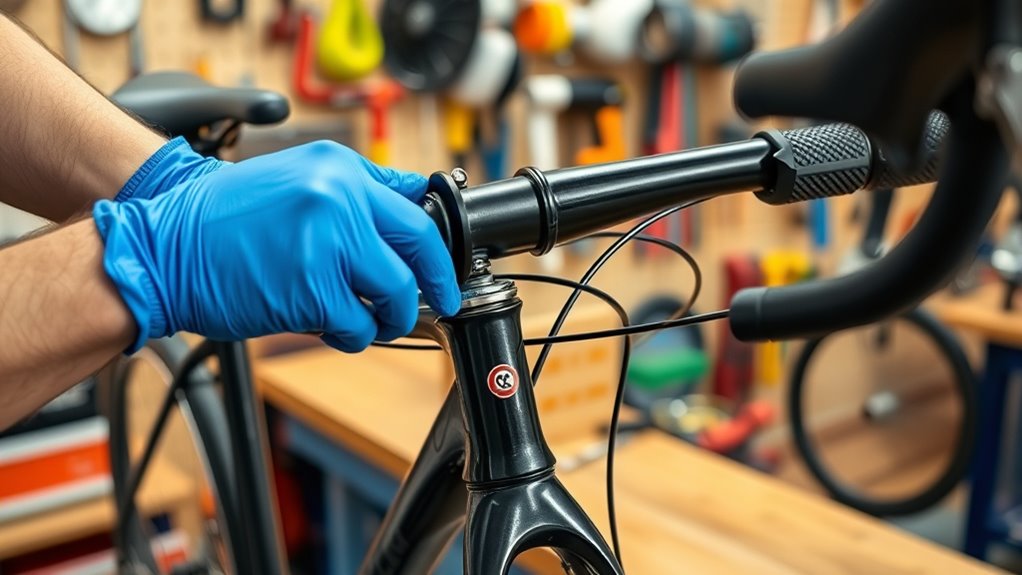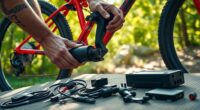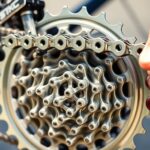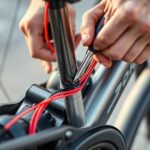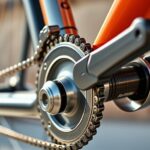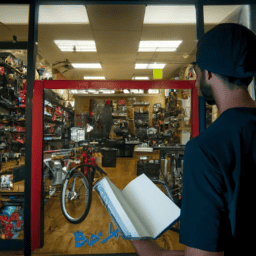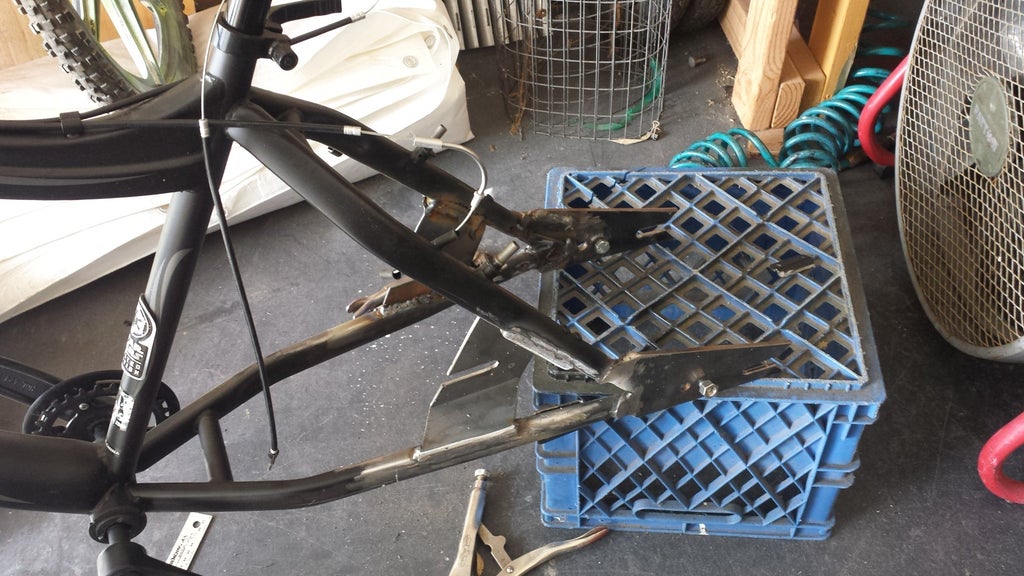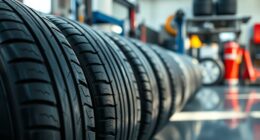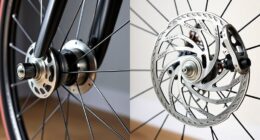To maintain your bicycle, start with routine safety checks like inspecting air, brakes, and chain. Clean and lubricate drivetrain parts regularly to keep everything smooth. Check tire pressure and examine for wear or damage to avoid flats. Adjust brakes and gears for proper shifting and stopping power. Keep a basic toolkit handy for small repairs and follow regular inspection routines. Keep at it, and you’ll discover how simple upkeep makes your rides safer and more enjoyable.
Key Takeaways
- Perform routine safety checks using the ABC method—air, brakes, chain—before each ride.
- Regularly clean and lubricate drivetrain components and pivot points to ensure smooth operation.
- Monitor tire pressure with a gauge and inspect for wear, cracks, or embedded debris regularly.
- Adjust brakes and gear systems for proper alignment, tension, and smooth shifting to enhance safety.
- Carry essential tools like a multi-tool, tire levers, and a mini-pump for roadside maintenance and repairs.
Conducting Routine Safety and Inspection Checks
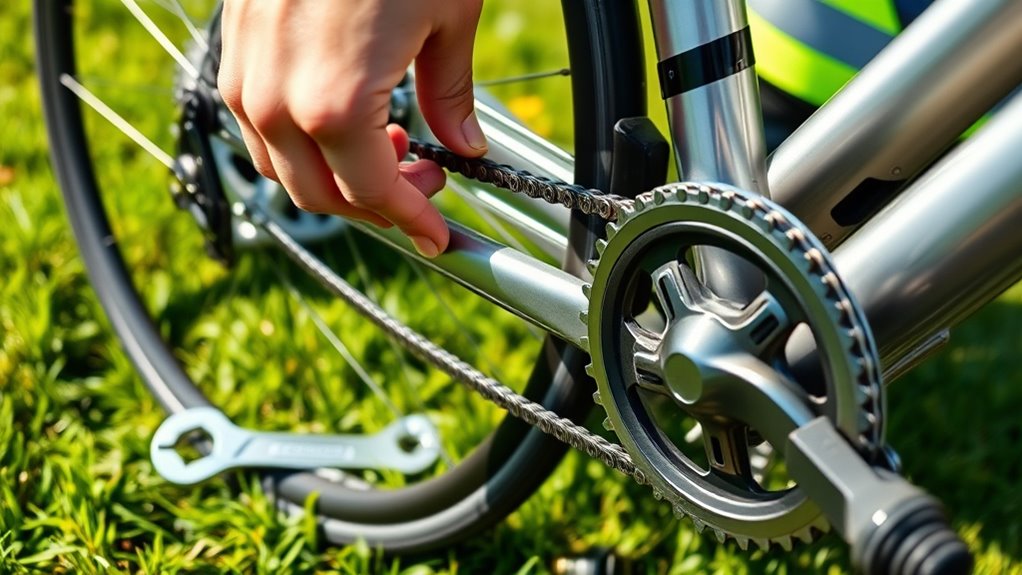
Before every ride, it’s essential to perform a quick safety and inspection check to guarantee your bike is in top condition. Use the ABC method—Air, Brakes, Chain—to verify everything. Check tire pressure to ensure proper inflation and smooth rolling. Test brake function by squeezing the brake levers; ensure brake pads are wearing evenly and replace them if grooves are gone. Spin the wheels to confirm wheel alignment and that they turn freely without rubbing against brake pads or the frame. Inspect the chain condition, making sure it’s clean and properly lubricated. Tighten loose bolts and quick-release levers to prevent component failure during your ride. Also, perform a brake adjustment if needed and do a thorough safety check to catch any issues before hitting the road. Remember, performance tuning can influence how well your bike performs, so keeping components in optimal condition is crucial. Regularly inspecting your bike’s vital components helps prevent unexpected failures and prolongs the lifespan of your bicycle. Additionally, checking your headphones for any wear or damage can ensure your riding experience remains enjoyable and safe. Incorporating a routine visual inspection can help identify potential issues early and maintain your bike’s optimal performance.
Proper Cleaning and Lubrication Techniques

To keep your bicycle performing smoothly, proper cleaning and lubrication are essential. Start by thoroughly cleaning drivetrain components like the chain, cassette, and derailleur using a bike-specific degreaser and brushes to remove dirt and grime. After cleaning, dry all parts completely with a rag or compressed air to prevent rust, especially in wet conditions. Water exposure can accelerate corrosion, so ensuring dryness is crucial. Apply a lubricant sparingly to the inside of the chain while turning the pedals backward, ensuring even coverage, then wipe off excess to avoid dirt buildup. Focus on pivot points, brake pads, brake calipers, and shifters, applying lubricant to maintain smooth operation and reduce component wear. Regularly inspect and clean the brake system, including pads and rims or discs, to ensure effective braking and prevent contamination from debris. Using the right type of lubricant for your bike can also extend the lifespan of your components and improve overall performance. Additionally, choosing the correct bike maintenance supplies can make the upkeep process more efficient and effective. Proper lubrication not only enhances performance but also helps prevent component wear, saving you money in the long run. Incorporating preventive maintenance into your routine can further ensure your bicycle remains in optimal condition and ready for rides.
Maintaining Tire Pressure and Inspecting for Wear
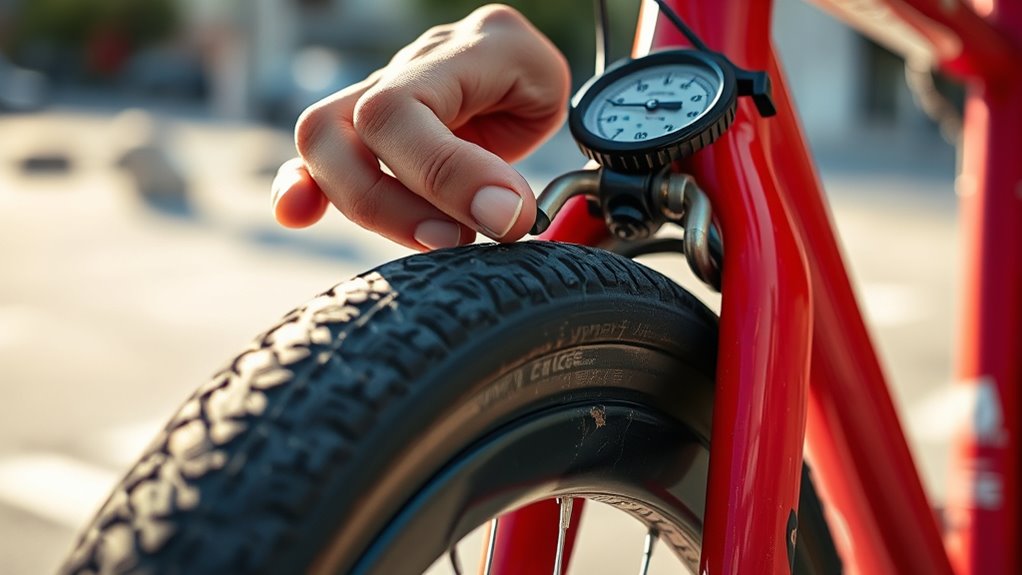
Ensuring your tires are properly inflated and free of damage is essential for safe and efficient riding. Regularly check your tire pressure with a reliable pressure gauge to match the PSI listed on the sidewall—typically 80-130 PSI for road bikes and 30-50 PSI for mountain bikes. Proper tire pressure improves ride efficiency and helps prevent flats. During tire inspection, look for signs of tire wear, such as cracks, cuts, embedded debris, or dry rot. Feel the tire surface for irregularities or bulges, which could indicate tire damage or weak spots. Check the tire tread depth and wear patterns to determine if tire replacement is necessary. Addressing these issues promptly keeps you riding smoothly and reduces the risk of sudden flat prevention. Additionally, inspecting the sidewalls for staining or discoloration can help identify aging or compromised tires before problems arise. Research into advanced tire compounds has led to innovations that enhance durability and grip, providing better performance over time. Moreover, keeping an eye on regular maintenance routines can prolong the lifespan of your tires and improve overall safety.
Adjusting Brakes and Gear Systems for Smooth Shifting

Achieving smooth braking and shifting depends on proper adjustments of your bike’s components. Start with brake adjustment by aligning brake pads so they contact the rim or rotor evenly, about 1-2 mm away. For gear system tuning, check derailleur alignment and adjust limit screws to prevent chain overshifting or drops. Fine-tune derailleur cable tension using barrel adjusters—tighten for harder shifts, loosen for easier ones. Inspect and replace worn brake pads and derailleur parts regularly to maintain performance. Test gear shifts by pedaling while shifting to ensure no skipping or hesitation. Properly setting these elements guarantees smooth shifting and effective braking, making your ride safer and more enjoyable. Additionally, derailleur alignment is crucial for ensuring that your gears shift smoothly without skipping or hesitation.
To keep your bicycle in top condition, consider upgrading your components as technology advances and can enhance your riding experience.
Essential Tools and Tips for Effective Bicycle Maintenance

Having the right tools is essential for effective bicycle maintenance and quick roadside repairs. A basic toolkit should include essential tools like a multi-tool, tire levers, a mini-pump or CO2 inflator, a chain tool, and a tire pressure gauge. High-quality, bike-specific tools—such as torque wrenches and chain breakers—help prevent damage and ensure precise repairs, especially for chain repair and brake adjustment. Carry a repair kit with spare tubes, patch kits, and necessary tools to handle common issues on the go, reducing downtime. Regularly check and replace worn tools to stay prepared. An accurate floor pump is vital for maintaining proper tire pressure, which improves ride quality and reduces flats. Proper storage and cleaning techniques are also important factors to consider when selecting a lifestyle to keep your bike in top shape for every ride. Incorporating regular inspection and maintenance routines can significantly extend the lifespan of your bicycle components and ensure safety during every ride. Additionally, understanding the Chevrolet Tuning concepts can inspire ways to optimize your bike’s performance through tailored upgrades and adjustments.
Frequently Asked Questions
What Is the Number 1 Rule for Bicycles?
The number one rule for bicycles is to perform regular safety checks before every ride. You should inspect your bike to guarantee all parts are working properly, like checking tire pressure, brakes, and the chain. Tighten quick-release levers and bolts to prevent issues mid-ride. By doing this, you reduce the risk of accidents, extend your bike’s life, and stay safe on every journey.
What Regular Maintenance Should Be Done on a Bicycle?
Think of your bike as a well-tuned orchestra that needs regular tuning. You should check your tire pressure every few days to keep the ride smooth and prevent flats. Lubricate the chain every 200-500 miles or bi-weekly to reduce wear. Inspect brake pads for wear and tighten loose parts regularly. Also, clean the drivetrain and frame after muddy rides to prevent rust, ensuring your bike performs flawlessly mile after mile.
How Do You Balance a Cycle for Beginners?
To balance your bike, start by adjusting the saddle so your leg is almost fully extended at the pedal’s lowest point, giving you control. Practice riding in open, flat areas, keeping your eyes forward and hands relaxed. Stay centered and relaxed over the bike, shifting your weight subtly to stay stable. Use gentle pedaling, avoid sudden turns, and look ahead to help maintain your balance and stay upright.
What Tools Do I Need for Basic Bike Maintenance?
You’ll need a basic toolkit to handle common bike repairs. Grab a multi-tool with Allen keys, screwdrivers, and a chain tool for versatile fixes. Carry a portable pump or CO2 inflator to keep your tires properly inflated. Tire levers help you remove and install tires easily during flats. A chain checker or wear gauge will tell you when it’s time to replace your chain. Finally, use bike-specific lubricants and degreasers to keep your bike running smoothly.
Conclusion
Regular maintenance keeps your bike safe and running smoothly, much like a well-oiled machine. Think of it as a simple daily ritual that prevents bigger issues later on. If you believe in the “if it ain’t broke, don’t fix it” theory, consider this: small, consistent checks can save you from costly repairs and accidents. Keep up with routine care, and your bike will serve you reliably for miles to come.
